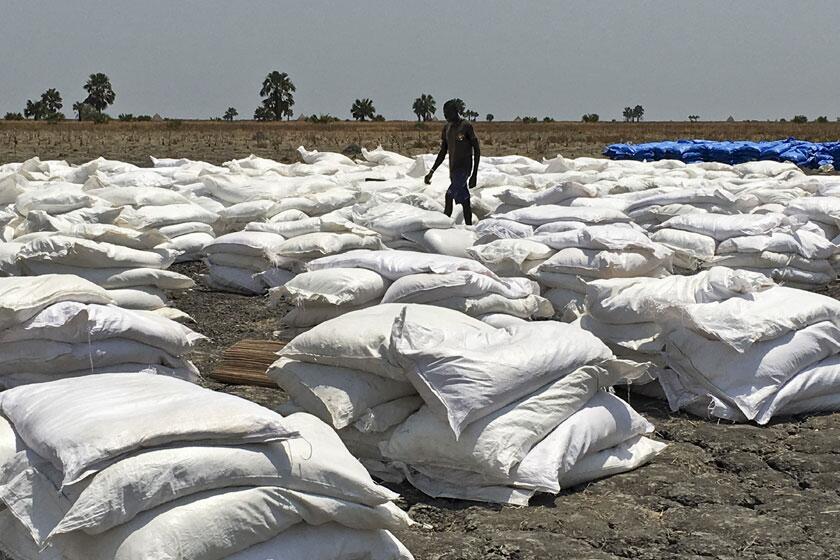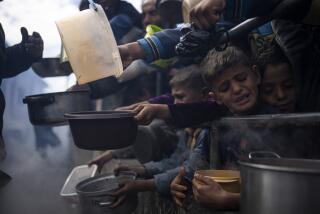The U.N.’s World Food Program, recipient of the Nobel Peace Prize, keeps focus on reaching zero global hunger

The U.N.’s World Food Program, this year’s recipient of the Nobel Peace Prize, puts the problem of global hunger bluntly: “690 million people still go to bed on an empty stomach each night.”
In a world where enough food is produced to feed all of its 7.8 billion inhabitants, the program contends that this issue shouldn’t exist.
Yet the organization’s officials estimate hundreds of millions of people are starving worldwide, which makes their goal to reach zero world hunger by 2030 seem extraordinarily ambitious.
The emergence of the coronavirus — which had killed more than 1.1 million people worldwide and infected more than 44 million as of Thursday — is expected to increase the number of people needing meals by many millions. Without an additional $5 billion in funding, said Steve Taravella, World Food Program senior spokesman, the program will fall short of the world’s needs during the next six months.
“Some people are likely to die simply because we cannot reach them in time,” Taravella said.
The World Food Program, which began in the early 1960s and serves more than 80 countries, relies mainly on international government contributions. Of about $8 billion in funds last year, $3.4 billion came from the U.S.
The United Nations’ World Food Program has been awarded the 2020 Nobel Peace Prize for its efforts to combat hunger across the globe.
Here is more information about the World Food Program:
Background
Established in 1961, the World Food Program began as a three-year experiment to distribute food. It served as a global emergency responder and became a permanent part of the United Nations as natural disasters and conflict ensued.
Today, the program is the world’s largest humanitarian agency, with about 18,000 staffers spread around the world. It operates in some of the world’s most war-torn areas, such as Yemen and Syria. It also partners with other local and international organizations to chip away at underlying causes of hunger. It is funded by donations from individuals, corporations and governments, and is governed by an executive board of representatives from 36 countries who set goals, create policy and oversee its activities.
Chad, Liberia, Haiti, Rwanda, Madagascar and North Korea were the countries with the worst chronic hunger from 2017 to 2019, according to the United Nations. Several other countries may fall within that category but did not report their data.
Adapting to COVID-19
The program works with each country’s health protocols without using a top-down approach in pursuing its goal of providing food aid. Its 18,000 field workers collaborate with local officials to determine each community’s specific needs. In coping with the COVID-19 pandemic this year, that has generally meant following social distancing and other precautions advised by many health authorities.
“The basic principles of infection control are the same regardless of location — keeping distant from other people, washing hands frequently, wearing masks to prevent transmission, isolating from others if one has become infected,” Taravella said. “Many settings we work in make that more difficult, but the fundamentals are the same.”
During the pandemic, World Food Program teams, for example, have worked day and night to prepack food for more than a million refugees in northern Uganda, according to a video shared by the program’s Twitter account. Some workers filled empty sacks with a few potfuls of corn buds, while others poured maize oil into empty water bottles. Cups of salt were packaged into brown paper bags. This helped refugees get in and out quicker with their groceries.
There have also been efforts by communities facing severe food needs to help control the spread of the coronavirus. In the Cox’s Bazar refugee camp in Bangladesh, about 40 women began sewing masks for their community after their clothing business slowed down. The U.N. says these women are being paid for their work by the U.S. Agency for International Development.
Taravella said World Food Program workers are required to take their temperatures daily at the Cox’s Bazar refugee camp. If a fever is detected, workers self-isolate and medical officials provide further guidance. He said at least six workers — three in Yemen and one each stationed in Bangladesh, Sudan and the Dominican Republic — have died this year of COVID-19.
Program’s vision
The World Food Program has identified what it calls five steps to zero hunger:
- Put the furthest behind first: “To realize the full potential of our globalized economy, national governments must expand social protection schemes for the most vulnerable.”
- Pave the road from farm to market: “We must also improve rural infrastructure, particularly roads, storage and electrification, ensuring farmers’ ability to reach a wider consumer base.”
- Reduce food waste: “In developed countries food is often wasted on the plate, while in developing countries it is lost during production, as crops go unused or unprocessed because of poor storage or because the farmers cannot get their goods to market.”
- Encourage a sustainable variety of crops: “Today across the globe, four crops (rice, wheat, corn and soy) represent 60% of all calories consumed. Addressing the challenges of climate change, and food availability and food access, will require helping farmers explore and identify a more diverse range of crops.”
- Make nutrition a priority, starting with a child’s first 1,000 days: “To prevent stunting and to promote healthy development, we must ensure that children and nursing mothers have access to the required nutritious foods.”
Caitlin Welsh, director of the Center for Strategic and International Studies’ Global Food Security Program, said inefficiencies will always afflict mammoth programs such as the World Food Program and noted it should be celebrated for undertaking a “huge challenge,” especially during the pandemic and economic recession.
“It’s the responsibility of local government to curb violence, to come together to address climate change,” Welsh said. “When we don’t see that happening, that’s when the World Food Program comes in.”
More to Read
Sign up for Essential California
The most important California stories and recommendations in your inbox every morning.
You may occasionally receive promotional content from the Los Angeles Times.












